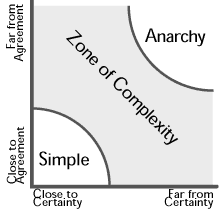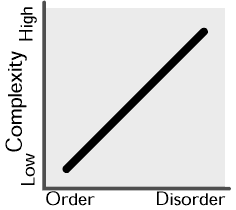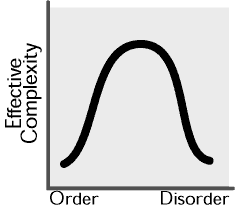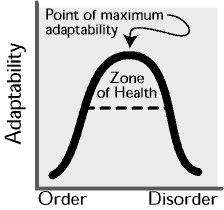|
Quality: Getting Beyond the Basics
With Complexity
Digest of a presentation by Paul Plsek, Mark Levine
M.D.,
Tuesday, April 27, 1999
Answers the questions:
- How can we reenergize our quality efforts using complexity
principles?
- How can we add a human element to our quality programs?
Did the quality movement fail?
Time and again, Paul Plsek hears people report frustration
and dissatisfaction with the quality efforts in their organizations.
The story is often the same: After gathering lots of data, doing a lot
of smart thinking and putting plans into place... “stuff” happens and
random occurrences undermine the effort. So practitioners of quality
principles go back to the drawing board and do some more analysis...
only to find that other “stuff” happens to stymie progress.
Which prompts Plsek to ask the question, what is this
“stuff?” Complexity theory offers a way of dealing with the stuff
— the random, uncontrollable fluctuations and occurrences within systems
that cause so much disorder.
The quality movement did not fail. It did, however,
reveal some blind spots in the prevailing management theory. It also
revealed a lot of important questions that theorists are now addressing.
A Quick Crash Course in Complexity.
To understand what is happening in our organizations, says Plsek, it
is important to understand some of the basic principles of complexity
science, and complex adaptive systems.
Here is a technical definition of complex adaptive
system (or CAS): A CAS is a collection of individual agents that have
the freedom to act in ways that are not always totally predictable,
and whose actions are interconnected such that one agent’s actions changes
the context for other agents.
A colony of termites is a complex adaptive system. So
is your immune system. The stock market, your brain, rush-hour traffic
and just about any collection of human beings are all CASs. There are
some things that are known to be true about complex adaptive systems:
- The elements of the system can change themselves.
Any member of the system is able to change spontaneously, which alters
the nature of the larger system. We spend a great deal of time trying
to change systems. Truth is, systems change themselves because their
members change.
- Complex outcomes can emerge from a few simple rules.
The popular “Boids” computer simulation demonstrates how just a few
instructions (like “fly to the center of the flock”; “stay only a
certain distance,” etc.) produce the remarkably complex behavior of
flocking.
- Small changes can have big effects. Maybe we’re
frustrated in our efforts, because we think that in order to have
a big change, we need a big change program. But even tiny fluctuations
in a CAS can erupt in sweeping, system-wide change (popularized by
the concept of the butterfly effect.)
- Continual creativity is a natural state of the system.
A hallmark of CASs is that they produce novelty. Leaders worry about
how to squeeze more innovation out of the people — but maybe it’s
already there. (Perhaps the challenge is to remove the many restrictions.)
- Forecasting is inherently an inexact, yet boundable,
art. Meteorologists can’t predict the data more than three days out.
Think about that next time you draw up a strategic plan!
- Things can be orderly, even without central control.
Think of a flock of birds. Which bird is the CEO? There is no central
control in a flock, a forest or the internet. (So maybe your organization
doesn’t really need a Quality Improvement council!)
- There are systems within systems, and that matters.
You may have experienced the frustration of “fixing” or even removing
parts of a system, without seeing the expected overall change. That’s
because the many sub-systems are interconnected, creating an output
greater than the sum of the parts.
- Life proceeds forward through constant tension and
balance. Don’t shun uncertainty and tension. These are natural parts
of systems. In order to have a healthy forest, there must be periodic
forest fires.
 Many
leaders think that learnings such as these are suggesting they embrace
complete anarchy and chaos. But that is not the case. When one abandons
the machine-like mindset, they don’t have to abandon all planning and
control along with it. Many
leaders think that learnings such as these are suggesting they embrace
complete anarchy and chaos. But that is not the case. When one abandons
the machine-like mindset, they don’t have to abandon all planning and
control along with it.
There is a middle zone — the zone of complexity — which
indicates that a certain level of agreement and certainty is healthy.
But how much? Herein lies the mystery.
Experience is showing that many of the most perplexing
quality issues fall within this zone of complexity. No wonder that managers,
who continue to use analysis and linear tools, continue to be frustrated.
Quality issues in the zone of complexity require a different approach.
Are you and your organization in the zone of complexity?
Perhaps. You may be in the zone if:
- ...you feel frustrated at the way things are, and
your attempts to change them haven’t worked;
- ...you find only moderate levels of certainty and
agreements within the system.
Some final thoughts. Complexity theory introduces these
concepts to organizational thinking:
- New metaphors. Consciously or not, we have
approached our organizations as if they operated like machines. But
what if we viewed our organizations as living systems?
- Simple rules. We may be over-planning, over-controlling
and over-measuring. Complexity suggests that a few simple principles
can create a remarkably rich environment.
- Appropriate clockware and swarmware. Don’t
throw the baby out with the bath water; sometimes traditional, mechanistic
“clockware” approaches are helpful. Other times, it’s better to go
with living-system inspired “swarmware” approaches. A healthy system
knows when to employ both.
- Tuning from within. The leader does not exist
outside of the system, like a puppeteer. Instead, the leader is part
of the system. The leader can change the system by changing himself.
- Non-linear change points. Traditional ideas
of cause and effect don’t apply in the zone of complexity. Instead,
look for the counter-intuitive and small opportunities to leverage
change in the system.
- Exploring the environment. A healthy system
interacts with and is influenced by its environment. Look for relationships
outside of the company that can bring rich new perspective and possibilities.
- Natural attractors and flows.
Just as marbles will all group together at the bottom of a glass bowl,
systems organize around invisible attractors. Instead of forcing change,
introduce a new attractor around which peo-ple and activity can organize.
So What Does Complexity Theory Have to Offer Medical
Practices?
Albert Einstein said “We shall require a substantially
new way of thinking if mankind is to survive.” So what does complexity
science have to offer medical practices? Acknowledging that medical
practices are still in the embryonic stage of employing the complexity
approach, Mark Levine shares these conclusions:
- We have to introduce a new meaning of “health”
- We have to focus on relationships.
- We must tease out our underlying assumptions about
managing medical practices.
- We need to boost the flow and quality of information.
- We must find the leverage points in the system.
 In
the traditional view, order is a desirable thing. The more com-plexity
increases, the more disorder is created — and the more systems begin
to fall apart. Complexity, in this world view, is bad and leads to anarchy. In
the traditional view, order is a desirable thing. The more com-plexity
increases, the more disorder is created — and the more systems begin
to fall apart. Complexity, in this world view, is bad and leads to anarchy.
But there is a healthier, more effective complexity
in which there is a balance between order and disorder. In the graphic
in the next column, systems that fall in the mid-zone of the curve are
the most complex, and the healthiest.
This has important implications for leaders. With this
new mental model the leader becomes a context manager, helping the sys-tem
to balance in that healthy state between order and disorder.
 For
example, in the Oscar-winning movie “Life is Beautiful,” the main character
(played by Roberto Benigni) helped his young son cope with the horror
of being in a concentration camp during the Nazi holocaust. He did this
by telling his son that the entire experience was a game. By helping
his son re-imagine the experience, he enabled his son to respond to
the harsh environment in a very productive way. This is what is meant
by becoming a context manager. For
example, in the Oscar-winning movie “Life is Beautiful,” the main character
(played by Roberto Benigni) helped his young son cope with the horror
of being in a concentration camp during the Nazi holocaust. He did this
by telling his son that the entire experience was a game. By helping
his son re-imagine the experience, he enabled his son to respond to
the harsh environment in a very productive way. This is what is meant
by becoming a context manager.
Similarly, leaders can become context managers in health
care by helping people re-imagine the current reali-ty. For example,
the current health care system is very dis-ease oriented. What would
happen if the system adopted a health orientation?
This context shift — from a disease focus to a health
focus — is particularly important. The World Health Organization recognized
this when it drafted this definition of health: “Health is the ability
of an individual to achieve his/her potential and to respond positively
to the chal-lenges of the environment.”
 Mark
Levine further embellishes this definition by defining health as “that
state of wholeness in which the individual is poised for maximal adaptability.
It is a state characterized by a dynamic tension resulting from the
interplay of inter-active forces at many differ-ent scales.” Mark
Levine further embellishes this definition by defining health as “that
state of wholeness in which the individual is poised for maximal adaptability.
It is a state characterized by a dynamic tension resulting from the
interplay of inter-active forces at many differ-ent scales.”
Systems in the midzone are best able to adapt. That
ability to adapt is health. Think of the tennis player who is ready
for the serve. He’s not standing stiff, but he’s not run-ning around
either. He is poised to adapt.
Note that this definition could refer to a team or organ-ization,
a cell, or your body. In each of these cases, health is not a static
state. Rather, variability is inherent and nor- Order Disorder Complexity
High Low Order Disorder Effective Complexity Order Disorder Zone of
Health Point of maximum adaptability Adaptability mal. By finding a
balance between too much order and dis-order, systems are poised for
maximum adaptability.
As a corollary to this new definition of health, Dr.
Levine offers this definition of disease: “Disease is what occurs when
dynamic states become either overly ordered or overly disordered.” (Note
that these definitions of health and disease are further explored and
illustrated in the work of Dr. Ary Goldberger.)
Science Seeking Relationships
There is a quiet revolution taking place in the world of science. Call
it “Science Seeking Relationships.” Science magazine recently focused
on this, reporting that scientists who have been very reductionistic
in their approach are now saying “we need more information, and its
in the relationships.”
In The Annals of Internal Medicine, (Feb. 1998,
128:291) Donald Berwick wrote “...the model for [health care] improvement
does not just ask about local, ‘elemental’ aims; it asks about shared
systematic aims. It seeks the meas-urement of systemic progress, not
just the performance of the parts; and the changes it refers to are
changes in system designs and interdependencies, not just changes in
the components of care.”
Why are relationships important? Because relationships
are the medium through which information is passed. And a healthy system
is one in which information (or “feed-back”) is flowing freely.
Dr. Losada wrote a paper called “The Complex Dynamics
of High Productivity Teams”. In his studies, Dr. Losada took teams
from a business context and put them in a research lab setting. There
he developed a method for encoding the speech interaction among the
team members. He found that there were three spheres of activity in
these interac-tions: positivity vs. negativity; self-focus vs. focus
on oth-ers; and advocacy for own activities vs. advocacy for oth-ers’.
As Dr. Losada studied teams based on these dynamics, he showed that
“low productivity teams” were stuck in neg-ativity, self-focus and and
self-advocacy. “High productivity teams” were not. Rather, they demonstrated
a very fluid dynamic which Dr. Losada described as “buoyant.” Here,
a scientific approach legitimizes what many already know intuitively:
that relationships matter.
This is no less true for the human relationships within
our organizations. There is a state of maximum adaptabili-ty that exists
between the polar extremes of absent rela-tionships and enmeshed, destructive
relationships. This healthy midzone is a desirable state physiologically
(as between organs) as well as relationally, between people. Human relationships
have been shown to be effective in treating disease. Imagine what they
could do for an organ-ization.
Leverage Points for Change
A CAS is governed by internal rules. Take
a closer look at these rules, and you’ll see that they are really assumptions
held by individual members. These assumptions can limit the ways we
take in information. They are also leverage points for change.
For example, one health care leader knew there was a
need to improve care to diabetic patients in his organiza-tion. More
specifically, these patients were not receiving the proper foot care
— an important need for diabetics. The leader instituted one simple
procedural change: Nurses must remove the diabetic patient’s shoes and
socks, so that the doctor could see the patient’s feet. It was a small
change, perhaps even an obvious one. But it led to signifi-cant changes
in the quality of care delivered to these patients.
Dr. Levine’s Conclusions
- The complexity perspective emphasizes the impor-tance
of looking at relationships.
- Relationships are a key to continuous improvement!
- A generative relationship is a caring relationship
between competent friends! Caring and competence are the answer!
- Should we be searching for new measures of relation-ships?
Why Aren’t Quality Efforts Spreading?
It’s a familiar story: A group in the organization figures out how to
do something better, and no one else adopts the improvements. Part of
the problem may be our tendency to dictate the new way, and tell people
to make it happen.
But complexity suggests a simpler way. Here are few
other points to keep in mind regarding the spread of inno-vation in
your organization.
- Remember that CASs are non-linear. Often times,
the pattern is for a change to languish within an organiza-tion, and
then suddenly “take root.” This has been demonstrated empirically
many times. If you consider how people adopt change, this makes sense.
As researcher Everett Rogers demonstrates, there are usu-ally a few
“early adopters,” but most people take a while to come around and
embrace the change.
- There is a momentum for the spread of new ideas.
Rogers shows that if 10% to 20% of the community adopts an innovation,
it’s often impossible to stop further diffu-sion of an idea! Thus,
it isn’t important to seek buy-in from everyone. If you can get a
small percentage of support, the idea takes on a life of its own.We
may be wasting our time by “thinking big.”
- Pay attention to boundaries and coupling. One nurse
found a new scheduling system that was used else-where in her profession.
She introduced it to her organization... and it faced criticism and
angry rejec-tion. In this case, the nurse was more connected to her
profession than she was to her organization — so no wonder the organization
didn’t buy it. She ran up against resistance because she sought to
introduce change through relationships that didn’t exist.
Once you understand this, you can begin creating linkages between
your team, your unit, your profes-sion and your organization. Draw
out maps that show the relationship between these groups. Then express
to these disparate groups the concept behind the idea, rather than
copying the exact form and shape of the idea.
Also, we always say “don’t reinvent the wheel.” But it turns out that
if you want ideas to spread, you have to allow reinvention of the
wheel. Communicate to peo-ple the principles, and let them come up
with their own way of doing it.
- Tuning the system versus driving it. The change
“driver” is inclined to forge a consensus and then began plan-ning
the change. But a “tuner” realizes “I don’t have to figure it all
out.” Instead, the tuner pays attention to the context and the connections
among groups. The tuner is comfortable with multiple approaches to
change, and doesn’t mind “muddling through,” as long as there is some
forward movement.
About the Presenters
Paul E. Plsek is actively involved in the
study and practice of com-plexity science and has been involved in various
VHA complexity man-agement initiatives since 1997.
Previously, he was an engineering manager in Bell
Laboratories and director of quality at AT&T Corporate Headquarters.
He has 20 years experience in helping organizations improve performance.
He has been in private practice as a consultant since 1985. He serves
part-time as a Senior Fellow at the Institute for Healthcare Improvement,
where he oversees international efforts. He has written numerous articles
and book chapters, and is a popular conference and seminar speaker.Plsek
authored or co-authored three books.
Plsek holds engineering degrees from Texas A&M University
and the Polytechnic Institute of New York.
Mark Levine, M.D., is a board-certified family
physician from Erie, Penn. He is currently the residency director for
the Hamot Family Practice Residency Program. In that capacity he has
been teaching principles of evidence-based practice for the last eight
years.
As a member of the VHA Complexity and Leadership
Learning Network for the past two years, he has participated in exploring
the application of complex system principles to health care. Dr. Levine
is particularly interested in utilizing the principles of complexity
to improve ambulatory practice and community health.
|